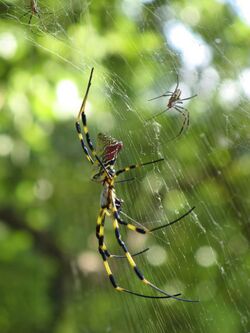Biology:Nephila clavata
| Nephila clavata | |
|---|---|

| |
| female with two males in Tokyo, Japan | |
| Scientific classification | |
| Domain: | Eukaryota |
| Kingdom: | Animalia |
| Phylum: | Arthropoda |
| Subphylum: | Chelicerata |
| Class: | Arachnida |
| Order: | Araneae |
| Infraorder: | Araneomorphae |
| Family: | Nephilidae |
| Genus: | Nephila |
| Species: | N. clavata
|
| Binomial name | |
| Nephila clavata L. Koch, 1878[1]
| |
| Synonyms | |
|
N. limbata | |
Nephila clavata, also known as the Jorō spider (ジョロウグモ(女郎蜘蛛、上臈蜘蛛) Jorō-gumo), is a member of the golden orb-web spider genus. The spider can be found throughout Japan except Hokkaidō, in Korea, Taiwan, China , and more recently, Northeast Georgia in North America.[2][3][4] Due to the large size as well as the bright, unique colors of the female Nephila, the spider is well-favored in Japan.
Recently scientists have confirmed the first known occurrence of N. clavata in North America.[2]
Characteristics
Nephila clavata pass winter as eggs and scatter as tiny juveniles in the spring. The female's body size is 17–25 mm, while the male's is 7–10 mm.
The web of female Nephila can reach one meter in width; the yellow threads appear rich gold in sunlight. The structure of the web seen in cross section is unusual for an orb web; it has 3 layers: the central orb, plus 2 irregular layers in front and behind the orb.
The adult female individual has stripes of yellow and dark blue, with red towards the rear of the abdomen. In autumn, smaller male(s) may be seen in the female's web for copulating. After mating the female spins an egg sack on a tree, laying 400 - 1500 eggs in one sack. The life cycle ends by late autumn or early winter.
Silk
Researchers, led by Masao Nakagaki, at Shinshu University, Japan have succeeded in creating a silk thread that is stronger, softer and more durable than conventional silk by injecting silkworm eggs with genes of the spider. The silkworms that hatch weave cocoons containing 10% spider protein. The dragline silk is said to have many uses, such as: bulletproof vests, sutures after an operation, tennis rackets, fishing line, and nets. A Japanese manufacturer named Okamoto had begun developing commercial applications for the spider silk, and planned to release extra-thin, durable spider socks by year 2010.[5][6]
In folklore
Jorōgumo is a legendary creature in Japanese folklore. A Jorōgumo is a spider which can change its appearance into that of a beautiful woman. She seeks men to seduce, whom she then binds in her silk and devours.
File:Joro Spider (Nephila clavata).webm
Gallery
Female shown on a web at a military base in Aibano, Japan .
Female with a male in the background on Enoshima-Isle, Japan
Female spider eating a ladybug in South Korea .
Nephila clavata web on electric power cable (Tanabe, Wakayama, in October 2007)
Female; taken on November 20, 2010 in Ibaraki, Japan .
See also
References
- ↑ "Taxon details Nephila clavata (L. Koch, 1878)". World Spider Catalog. Natural History Museum Bern. http://www.wsc.nmbe.ch/species/22433.
- ↑ 2.0 2.1 "Nephila clavata L Koch, the Joro Spider of East Asia, newly recorded from North America (Araneae: Nephilidae)". PeerJ 3: e763. 2015-02-05. doi:10.7717/peerj.763. PMID 25699210.
- ↑ Shearer, Lee. "Madison County man captures spider never before seen in North America". Athens Banner. http://www.onlineathens.com/uga/2014-10-30/madison-county-man-captures-spider-never-seen-north-america.
- ↑ Drake, Nadia (2015-03-19). "Asian "Fortune-Teller" Spider Found in U.S. for First Time". National Geographic. https://news.nationalgeographic.com/2015/03/150319-joro-spiders-animals-science-invasive-species-asia-nation/.
- ↑ "Silk Socks, a New Biotech Product". The Silkworm Blog. 10 December 2007. http://silkwormmori.blogspot.com/2007/12/silk-socks-new-biotech-product.html.
- ↑ "Soon, socks and bulletproof vests made from spider silk". Thaindian News. 12 October 2007. http://www.thaindian.com/newsportal/health/soon-socks-and-bulletproof-vests-made-from-spider-silk_1008330.html.
External links
| Wikimedia Commons has media related to Nephila clavata. |
Wikidata ☰ Q136925 entry








